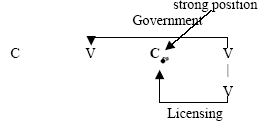
How morphology can interfere in phonology: # = CV in French suffixal derivation
Claudine Pagliano
University of Nice
This talk examines the phonological effects that certain suffixal boundaries produce in French. I claim that consonantal epenthesis at the seam of a stem and certain suffixes (e.g. numéro-t-er, têtu-t-esse) is the phonological trace of the morphological boundary, which identifies skeletal space. The insertion of this extra skeletal volume creates a situation whereby the empty initial onset of the suffix comes to stand in a strong position. Epenthesis, then, is in fact a form of fortition.
French suffixal derivation is characterized by the insertion of a consonant, mostly t, between the stem and certain suffixes (data from an elaborated corpus of 272 derived words displaying an epenthetic consonant before the suffix, cf. Pagliano 2003). Contrary to common belief, hiatus is not the triggering context for this epenthesis: all hiatuses are not broken up by epenthesis (e.g. bleu-ir, bleu-âtre), and epenthesis also occurs after consonants (e.g. atlas-t-ique, cuir-t-ure). However, the epenthesis at hand is always pre-vocalic.
A further conditioning factor is the kind of suffix that is added: the infinitive -er for instance triggers epenthesis (bleu-t-er), but the adjectival suffix -âtre is never observed with a parasitic consonant (bleu-âtre, *bleu-t-âtre).
Hence, epenthesis is due to the conjunction of two factors: the presence of a vowel-initial suffix, and the very nature of the suffix itself.
Since a solution based on the hiatus context is not eligible, I argue that the cases where epenthesis occurs after consonants reveal the actual mechanism at work: epenthesis in fact is a form of strengthening, and strengthening typically occurs in so-called strong positions: word-initially and after consonants. In the theory developed by Scheer & Ségéral (2001), strong positions occur after empty Nuclei because C2 in C1øC2V will be licensed (by V) but ungoverned (V is called to govern ø).

However, in a word like numéro-t-er, how could there be an empty nucleus between the o and the t? I argue that the extra syllabic space is inserted upon a morphological order. Morphology distinguishes between at least two kinds of suffixes in French (in the same way as in English, cf. e.g. Siegel 1974): type one provokes epenthesis, while type two does not. The phonological exponent of this morphological contrast is the presence vs. the absence of an empty CV unit.
The analysis that I develop grants a phonological identity to a morphological object. This allows for a predictive treatment of morphological information: an empty CV unit is an ordinary phonological object whose behaviour may be predicted. By contrast "#", "+" and the like are not expected to behave in any specific way: they can trigger any phonological effect and its reverse.
References:
PAGLIANO, Claudine 2003. L'épenthèse consonantique en français. Ce que la syntaxe, la sémantique et la morphologie peuvent faire à la phonologie: parles-en de ta numérotation ʔimpossible. PhD dissertation, Université de Nice.
SCHEER, Tobias & Philippe SÉGÉRAL 2001. La coda-miroir, Bulletin de la Société de Linguistique de Paris XCVI, 107-152.
SIEGEL, Dorothy 1974 [1979]. Topics in English Morphology. PhD dissertation, MIT.